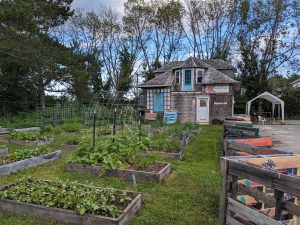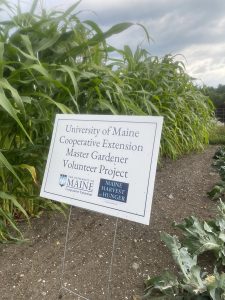Community Garden Map

Community gardens are “collaborative projects on shared open spaces where participants share in the maintenance and products of the garden, including healthful and affordable fresh fruits and vegetables” (1). Community gardens are important resources for towns and neighborhoods as they have the reciprocal effect of benefiting the community, environment, and individuals who participate (2, 3).
Numerous health and wellbeing outcomes have been reported as a result of participating in a community garden:
- Promote a sense of belonging: The social aspects of community gardens can attract residents who may not normally engage in gardening activities, but see it as an opportunity to be seen or remain active in their community (2).
- Expand social networks: Many families with children have found community gardens to serve as a social network, and in some cases, a safe space for kids to play while adults tend to their plots (4, 5).
- Improve physical health: Community gardeners often experience improved physical health through the natural ways in which gardening serves as exercise and increases their daily consumption of vegetables (2, 5, 6).
- Enhance mental health: Engaging in gardening activities provides residents with the opportunity to relax, decompress and enjoy their time outdoors (2, 3, 4, 7).

The purpose of developing this community garden map is to help connect Mainers with community gardens in their area and how they can become involved. There are three major categories of community gardens on the map we’ve developed, and they include:
- Individual: Gardens to grow your own food on your own plot
- Collective: Gardens where a group grows food for community need
- Both: Gardens that have both individual plots and collective growing for community need
Frequently Asked Questions
Who do I contact about the community gardens on the map?
Please directly contact the community garden for more information, including how to acquire or apply for a plot.
How do I add my community garden to this map?
Please complete this online form so we can add your community garden to the map. It may take up to 10 business days for your garden to appear on the map.
How do I update my community garden information on the map?
Please complete this online form so we can update your community garden information. It may take up to 10 business days to update your garden information on the map.
Note: This is the same form for adding new gardens.
For general questions about the map, please contact us at extension.gardening@maine.edu or phone number.
Educational Resources
Community Garden Organizers:
- Bulletin #4300, Steps to Organizing Your Community Garden
- Bulletin #4311, Planning and Managing a Community “Giving” Garden in Maine
- Pest management for community gardens (coming soon)
- Gleaning publication (coming soon)
Community Gardeners:
- Cooperative Extension: Garden & Yard
- Maine Gardener Manual
- Cooperative Extension Diagnostic and Research Laboratory: Pest Management Unit
- Victory Gardens for ME Series
- Garden Webinar Series
- On-Demand Webinars
- Master Gardener Volunteers Training
- Maine Horticulture Apprentice Training
- Maine Gardener Training
References:
1 NAL Agricultural Thesaurus (n.d.). Community gardens. USDA. Retrieved March 25, 2024.
2 Jackson, J. (2017). Growing the community – A case study of community gardens in Lincoln’s Abbey Ward. Renewable Agriculture and Food Systems, 33(6), 530-541. doi:10.1017/S1742170517000643
3 Bailey, A. & Jonathan Kingsley, J. (2020). Connections in the garden: Opportunities for wellbeing. Local Environment, 25(11-12), 907-920. doi:10.1080/13549839.2020.1845637
4 Dubová, L., Macháč, J., & Vacková, A. (2020). Food provision, social interaction or relaxation: Which drivers are vital to being a member of community gardens in Czech cities? Sustainability, 12(22), 1-18. doi: 10.3390/su12229588
5 Wakefield, S., Yeudall, F., Taron, C., Reynolds, J., and Skinner, A. (2007). Growing urban health: Community gardening in south-east Toronto. Health Promotion International, 22(2), 92–101. doi: 10.1093/heapro/dam001
6 Soga, M., Cox, DTC., Yamaura, Y., Gaston, KJ., Kurisu, K., & Hanaki, K. (2017). Health benefits of urban allotment gardening: Improved physical and psychological well-being and social integration. International Journal of Environmental Research and Public Health, 14(1), 1-13. doi: 10.3390/ijerph14010071
7 Schoen, V., Caputo, S., & Blythe, C. (2020). Valuing physical and social output: A rapid assessment of a London community garden. Sustainability, 12(13), 1-20. doi:10.3390/su12135452
